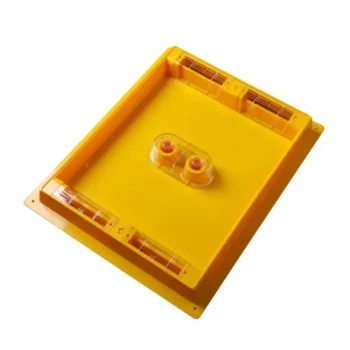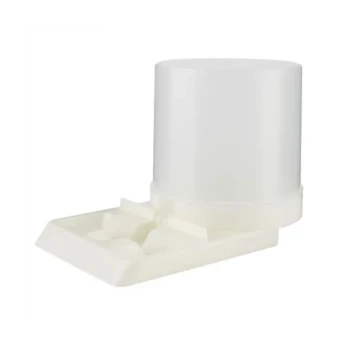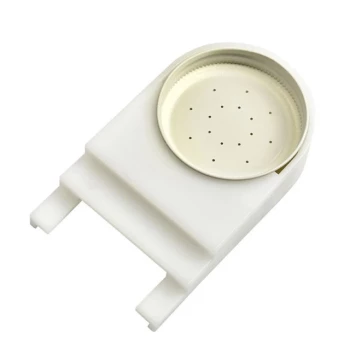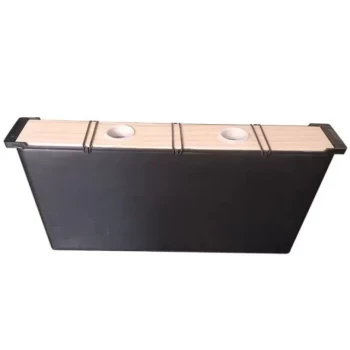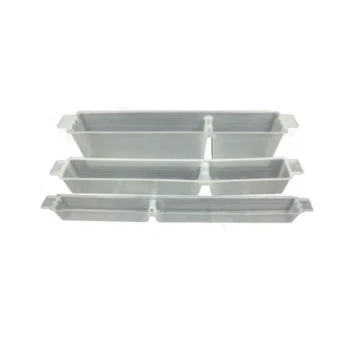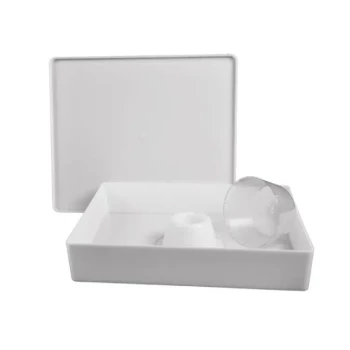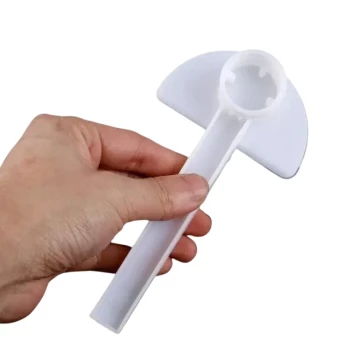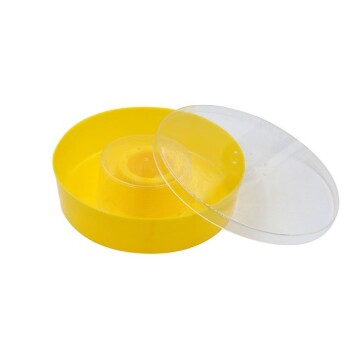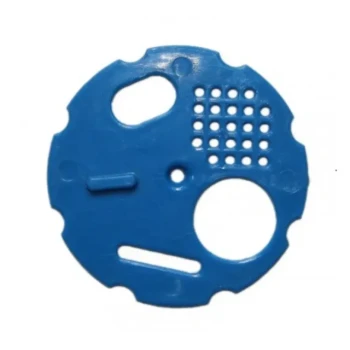At its core, a bee feeder can be any container that safely provides supplemental nutrition to a honeybee colony. You can use specially designed equipment like hive-top, entrance, or frame feeders, or even simple, clean food-grade pails. The key is to deliver the right food, at the right time, without introducing new risks to the hive.
The most critical decision is not what container you use, but how you feed your bees. Your choice of method—whether slow or fast, internal or external—directly impacts your hive's health, its vulnerability to attack, and the purity of its honey.
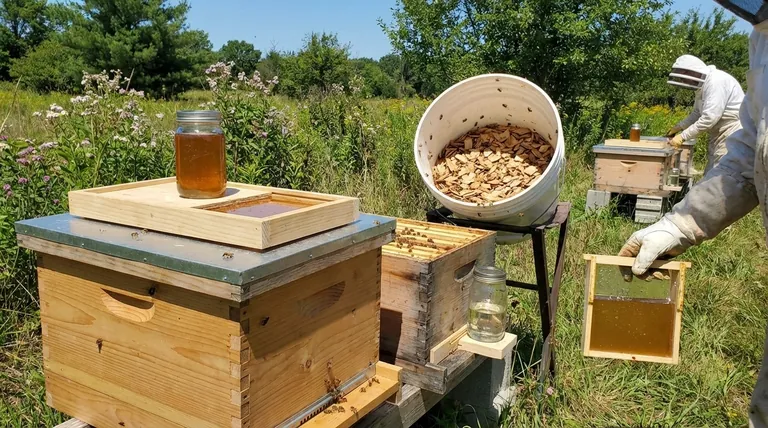
Understanding In-Hive vs. Open Feeding
The first decision you must make is whether to feed your bees inside the hive or out in the open. Each approach serves a different purpose and carries distinct risks.
In-Hive Feeders: The Controlled Method
In-hive feeders are placed inside the hive, on top of it, or directly in the entrance. This is the most common and recommended method for backyard beekeepers.
Examples include hive-top feeders, which sit on the uppermost box; frame feeders, which take the place of one or more frames inside a hive box; and entrance feeders, which allow bees access to a jar of syrup from the hive entrance.
This method gives you precise control, ensuring the feed goes only to the target colony. It significantly reduces the risk of attracting predators and inciting "robbing," where stronger hives attack and steal from your weaker, supplemented hive.
Open Feeders: The Community Method
Open feeding involves placing a large quantity of syrup in a container, such as a pail or trough, at a distance from your hives. This can be a practical way to feed many colonies at once.
You can use thoroughly washed, food-grade plastic pails, sometimes available from bakeries. It is critical to provide floating material (like wood chips or straw) in the syrup to prevent the bees from drowning.
While efficient for large operations, this method can encourage robbing, attract pests, and potentially facilitate the spread of disease between colonies.
A Closer Look at Common Feeder Types
The specific feeder you choose should align with your goal, whether it's emergency feeding for survival or gentle stimulation for growth.
Entrance Feeders
These small feeders screw into the hive's entrance. They are ideal for providing a slow, steady supply of syrup to a small colony, which helps stimulate the queen to lay eggs. Their small capacity and external placement, however, can make the hive a target for robbers.
Frame Feeders
These feeders are shaped like a brood frame and hang inside the hive body. They hold a larger volume of syrup and are well-protected from outsiders, minimizing the risk of robbing. Care must be taken to ensure bees have a way to climb out to avoid drowning.
Hive-Top Feeders
Placed on top of the hive but under the outer cover, these feeders hold a large volume of syrup. They are excellent for providing a large amount of food quickly with minimal disturbance to the colony, making them ideal for emergency feeding or preparing a hive for winter.
Understanding the Trade-offs
Simply providing food is not enough; you must understand the consequences of how and when you do it.
The Danger of Robbing
Exposed sugar syrup is an irresistible attractant for honeybees and other insects. Feeding a weak colony with an open or poorly secured feeder can trigger a frenzy where bees from stronger nearby hives invade and overwhelm the colony, stealing its resources and often destroying it. In-hive feeders are the best defense against this.
Fast Feed vs. Slow Feed
A fast feed delivers a large volume of syrup quickly (e.g., with a pail or top feeder) to avert starvation. A slow feed provides a smaller, steady supply (e.g., with an entrance feeder) that mimics a natural nectar flow, which encourages the queen to expand the brood nest. Using the wrong method for your goal can be ineffective or counterproductive.
The Purity of Your Honey
This is a critical rule: do not feed sugar syrup during a nectar flow if you intend to harvest honey. Feeding during this period will inevitably lead to bees storing sugar syrup in the honeycomb, adulterating the final honey product. Feeding is for helping the colony, not for increasing your honey yield.
Beyond Syrup: Feeding Protein
Bees also need protein, which they get from pollen. You can supplement this by providing pollen patties, a mixture of pollen or pollen substitute and sugar syrup. This is highly effective at stimulating brood rearing but must be timed correctly to ensure the new population of bees emerges when floral resources are available.
Making the Right Choice for Your Hive
Select your feeding strategy based on the colony's specific, immediate need.
- If your primary focus is preventing starvation in fall or winter: Use a high-capacity hive-top or frame feeder to deliver heavy 2:1 (sugar to water) syrup quickly.
- If your primary focus is stimulating a small or new colony in spring: Use a slow feeder, like an entrance feeder, to provide a light 1:1 syrup that mimics a natural nectar flow.
- If your primary focus is boosting the population for pollination: Provide pollen patties in late winter or early spring to encourage brood rearing before the main bloom.
- If your primary focus is producing pure, high-quality honey: Stop all syrup feeding well before the main nectar flow begins and do not resume until after you have harvested your honey.
Ultimately, successful feeding is about thoughtfully intervening to support your bees' natural cycle, not override it.
Summary Table:
| Feeder Type | Best For | Key Advantage | Key Consideration |
|---|---|---|---|
| Hive-Top Feeder | Emergency feeding, winter prep | Large capacity, minimal disturbance | Excellent for fast feeding |
| Frame Feeder | General in-hive feeding | Protected from robbers, large volume | Ensure bees have an escape route |
| Entrance Feeder | Stimulating small colonies | Mimics natural nectar flow | Can attract robbers due to placement |
| Open Feeder | Feeding multiple colonies | Efficient for large-scale operations | High risk of robbing and disease spread |
Equip Your Apiary with the Right Tools from HONESTBEE
Feeding your bees correctly is just one part of successful beekeeping. Having reliable, well-designed equipment is fundamental to protecting your investment and maximizing your hive's health and productivity.
At HONESTBEE, we supply commercial apiaries and beekeeping equipment distributors with high-quality, wholesale-focused supplies. From durable hive-top feeders to essential protective gear, our products are built to support the demanding needs of professional beekeepers.
Let us help you build a stronger, more resilient operation.
Contact HONESTBEE today to discuss your wholesale needs and discover how our equipment can contribute to your success.
Visual Guide
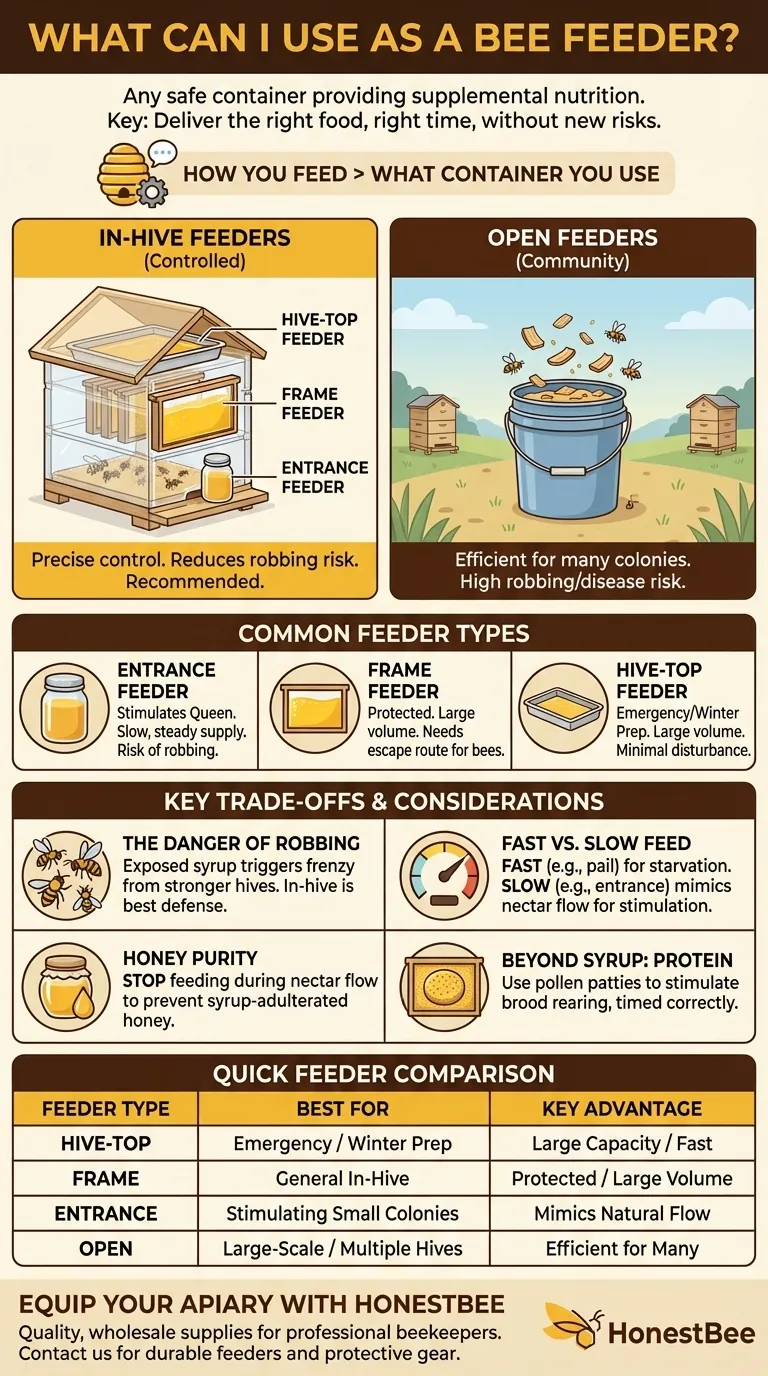
Related Products
- Boardman Entrance Bee Feeder Durable Galvanized Steel and Wood Construction for Beekeeping
- Professional Hive Front Entrance Bee Feeder
- Professional Hive Top Bee Feeder for Beekeeping
- HONESTBEE Entrance Bee Feeder Professional Hive Nutrition Solution for Beekeeping
- Classic Boardman Entrance Bee Feeder Hive Front Feeding Solution
People Also Ask
- Are entrance feeders good for bees? Prioritize Hive Health Over Convenience
- How to make an entrance feeder for bees? A DIY Guide for Safe & Effective Feeding
- What is an entrance feeder and how is it used? Avoid the Critical Risk of Robbing
- What is an entrance feeder? A Guide to Its Simple Design and High Robbing Risk
- How does an entrance feeder work? A Guide to Its Simple Mechanics and Risks


